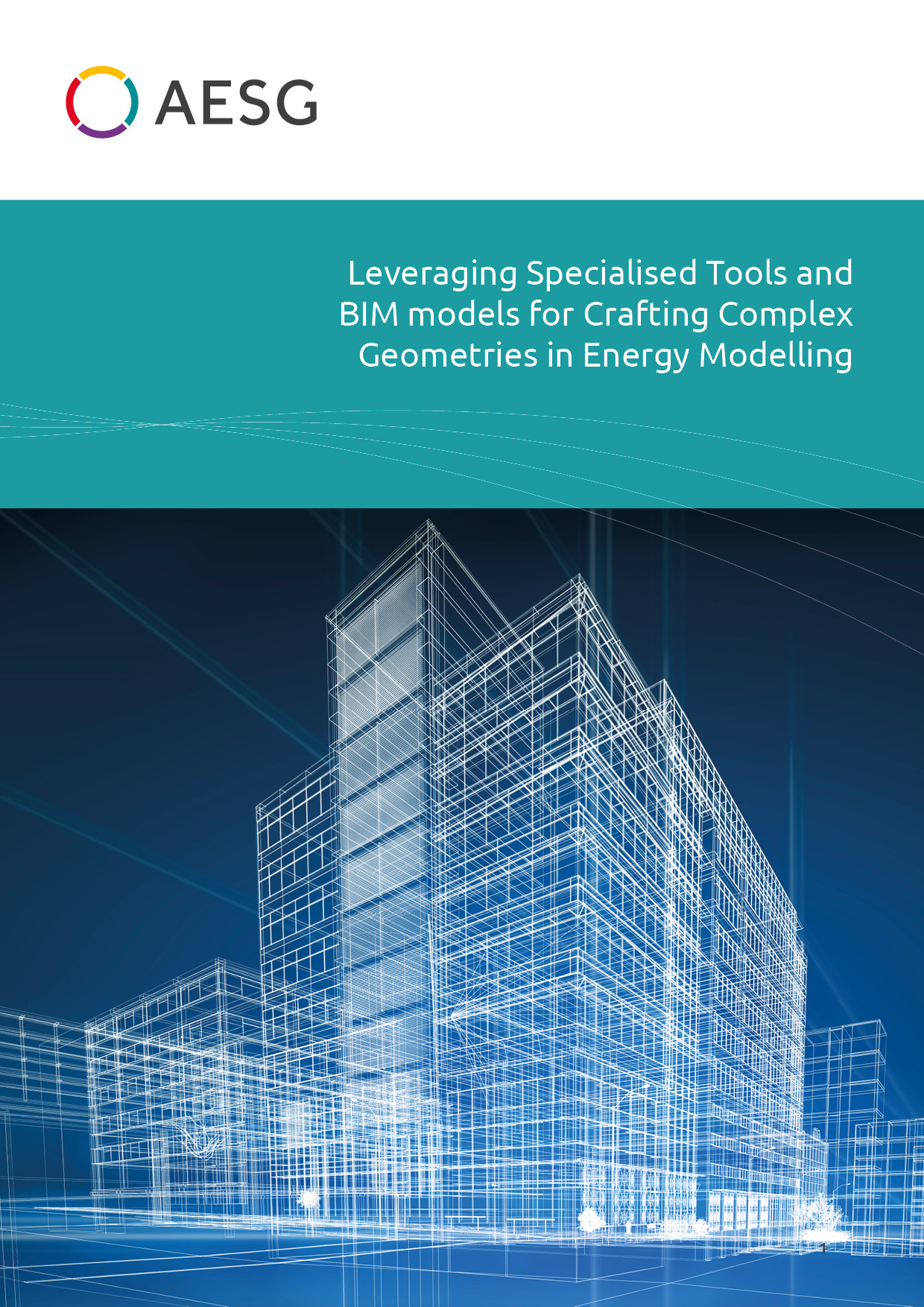
Executive Summary
This white paper underscores the crucial role of accurately modelling complex geometries in energy modelling, with a focus on employing specialised tools. Building Information Modelling (BIM) has gained widespread acceptance within the engineering and architectural community, and it is incumbent upon us to fully harness its capabilities. Ensuring comprehensive digital connectivity is essential, with BIM serving as the definitive “single source of truth.”
The design and analysis of buildings for optimal energy performance necessitate a nuanced approach to geometric representation. Conventional modelling tools often prove inadequate when confronted with intricate structures, underscoring the importance of utilising specialised tools that specifically address the unique requirements of energy modelling while remaining faithful to the architectural intent behind designing the building.
At AESG, we hold a profound respect for architectural and engineering design. We are committed to leveraging our team’s skills and utilising all available tools to ensure that the energy model faithfully replicates the actual design. This approach allows the model to serve as a Digital Energy Twin, a valuable resource during the operational phase of the building.
1 Introduction
1.1 Background
The increasing focus on sustainable building practices which revolves around BIM has intensified the need for accurate energy modelling. Achieving energy efficiency requires a detailed understanding of a structure’s geometry and its impact on energy consumption. This paper delves into the challenges associated with modelling complex geometries and covers images from energy modelling software for some of the sample geometries created using specialised tools BIM model being the “single source of truth”.
1.2 Objectives
• Explore the consequences of inaccurate geometric representation in energy modelling.
• Identify challenges associated with complex geometries.
• Analyse specialised tools for creating intricate building models.
• Highlight the benefits of using these tools in energy modelling.
• Exemplifying BIM models transformed with Specialised Tools for energy modelling.
2 Consequences of Inaccurate Geometric Representation
Inaccurate geometry can have significant consequences on the performance and reliability of an energy model. The accuracy of the geometry used in energy modelling is crucial for obtaining realistic and trustworthy predictions of a building’s energy consumption and efficiency. Here are several effects of inaccurate geometry:
2.1 Energy Consumption Miscalculation
Inaccurate geometry can lead to incorrect estimations of the building’s surface area, volume, and exposure to sunlight. These inaccuracies directly impact the calculations for heat gain, heat loss, and overall thermal performance. Consequently, the energy consumption predictions may deviate from the actual values.
2.2 Thermal Comfort Issues
Incorrect geometry can result in flawed predictions of internal temperature distribution within the building. This can lead to thermal discomfort for occupants, as the model may not accurately represent how different spaces respond to heating or cooling loads. In turn, this may prompt the implementation of inefficient heating, ventilation, and air conditioning (HVAC) systems, affecting the overall energy balance.
2.3 Renewable Energy System Sizing Errors
A net-zero energy building or building with renewable energy systems often relies on the outcome of energy modelling results. Sizing errors in these renewable energy systems can compromise the ability to achieve the targeted balance between energy consumption and production.
2.4 Design Optimisation Challenges
Design optimisation energy performance requires accurate geometric representation. Inaccuracies may impede the identification of opportunities for passive design strategies, such as optimal building orientation, efficient shading, and natural ventilation. Suboptimal designs may lead to missed opportunities for energy savings.
2.5 Operational Performance Discrepancies
Inaccuracies in geometry can impact the predicted operational performance of building systems. This may result in overestimation or underestimation of the effectiveness of energy-efficient technologies, influencing decisions regarding system specifications and configurations.
In summary, accurate geometric representation is fundamental for the success of energy modelling. Attention to precise geometric data is crucial for professionals engaged in energy modelling and sustainable building design.
3 Challenges in Modelling Complex Geometries
Acquiring accurate geometric data for structures that deviate from conventional shapes poses a notable challenge. This difficulty in obtaining precise geometric data is amplified when dealing with irregular structures, as traditional energy modelling tools may struggle to capture the intricacies inherent in these designs. The irregularities may include unconventional curves, asymmetric patterns, or irregular angles that demand specialised techniques for accurate data collection.
Moreover, the challenge extends beyond the physical measurement to the digital representation of irregular geometries, requiring sophisticated modelling approaches to faithfully recreate the complex structures within digital environments. As a result, energy modelling professionals involved in the acquisition of geometric data for irregular structures must navigate through intricacies to ensure a comprehensive and accurate representation, acknowledging the unique hurdles associated with capturing the true essence of such unconventional architectural forms.
4 Specialised Tools for Complex Geometries
In the present era, nearly all architectural models are crafted using BIM processes. The utilisation of parametric modelling tools enhances the ability to transform geometries for direct importation into energy modelling software, which not only improves the precision of energy simulations but reduces the modelling time too. However, the implementation of this process is not straightforward, as it involves the use of multiple tools to achieve the desired outcome. The complexity arises from the need to navigate through various software applications and methodologies, requiring a comprehensive understanding of each tool’s functionalities and their integration to effectively reach the intended modelling goals. Despite the intricacies involved, the advantages of employing parametric modelling tools in enhancing the accuracy of energy simulations make the effort worthwhile for professionals seeking comprehensive and precise representations of complex geometries in their projects.
5 Benefits of Specialised Tools in Energy Modelling
5.1 Improved Accuracy
Specialised tools, in addition to BIM models, provide heightened accuracy in modelling intricate geometries, resulting in more precise energy predictions. This, in turn, assists the operational team in establishing the operational energy budget for the building and enables the design team to craft renewable systems with greater precision.
5.2 Accurate Heat Gain Calculations
Conventional energy modelling software might encounter challenges when efficiently generating intricate geometries, leading to inaccuracies in assessing heat gain through the building envelope and ultimately resulting in flawed calculations of energy consumption.
5.3 Accurate Cost Benefit Analysis
Precision in geometry will yield a precise evaluation of the influence of passive measures, including U-Values, SHGC, shading, etc., on energy consumption. This, in turn, aids in conducting an exact cost-benefit analysis.
5.4 Enhanced Design Exploration
Specialised tools facilitate innovative design exploration while ensuring energy efficiency goals are met.
6 Exemplifying BIM Models Transformed with Specialised Tools for Energy Modelling
At AESG, our team consists of skilled energy modelers proficient in meticulously designing geometries to the highest standards. We possess a thorough understanding of the necessary digital tools to create precise energy models and value the significance of digital transformation. Beyond their proficiency in geometry, they possess advanced knowledge of HVAC systems, recognising their pivotal role. These experts meticulously model HVAC systems, ensuring a detailed representation that faithfully replicates the exact design.
Here are pictures depicting a couple of the intricate geometries created using specialised tools where the initial geometry is taken from Revit and post processed using specialised tools before importing to IESVE software for energy modelling.


Conclusion
This white paper has highlighted the critical role of accurate geometric representation in energy modelling and the challenges associated with complex structures. By embracing the relevant digital tools, professionals can overcome these challenges, ensuring accurate and more precise energy predictions in a timely manner, and fostering sustainable building practices.
Keywords: Energy Modelling, Complex Geometries, BIM, Digital Energy Twin, Specialised Tools, Digital Transformation, Parametric Modelling, Generative Design, Accurate Energy Prediction, Design Optimisation.
How AESG can help
AESG is an International Consultancy, Engineering and Advisory firm committed to driving sustainability in the built environment and beyond. With the highest calibre leadership team in our field, we pair technical knowledge with practical experience to provide hands-on, bespoke strategic solutions to our clients.
We have one of the largest dedicated teams with decades of cumulative experience in sustainable design, sustainable engineering, fire and life safety, façade engineering, commissioning, digital delivery, waste management, environmental consultancy, strategy and advisory, cost management and acoustics. Our prestigious portfolio demonstrates our extensive capabilities and our ability to consistently deliver best in class solutions to some of the industry’s most complex technical challenges.

Senior Associate – Head of Building Physics, AESG
Anas is working as a Building Physics Head at AESG, leading most of the services related to building design and its performance. Anas started his career as an HVAC Design Engineer and then chose sustainability as his career mainly focused on building components consuming electricity. Anas is an ASHRAE Certified Energy Modelling and Energy Auditing Professional. Anas’ HVAC design expertise allows him to optimise energy performance of the buildings and its surroundings in the most efficient manner.

Building Physicist, AESG
In his role at AESG, Tabish has been involved in developing Energy Models for some of the world’s most prestigious projects. With over 5 years of experience as an Architect in Sustainable Building Services/ Technology, he has developed a comprehensive understanding of energy analysis and sustainable design practices, throughout his career, he has successfully applied advanced modelling techniques to evaluate energy consumptions patterns, optimise building systems, propose energy-efficient solutions that align with sustainable environmental objectives.
For further information relating to specialist consultancy engineering services, feel free to contact us